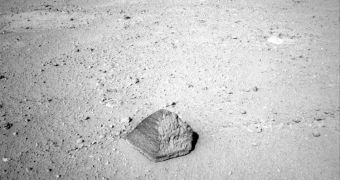The Mars Science Laboratory (MSL) rover Curiosity is currently about 2.5 meters (8 feet) away from a football-size rock called Jake Matijevic, which it plans to test its scientific instruments on. This is important because it will give mission controllers the chance to test the tools before arriving at Glenelg.
The latter is Curiosity’s first real science target, and is located around 400 meters (1,300 feet) from Bradbury Landing, where the rover first touched down on the Martian surface. Glenelg is an outcrop featuring three different types of rock, which may yield important geological information.
Jake Matijevic – named after MSL's operations systems chief engineer, who passed away on August 20 – is the first rock on which Curiosity will use the tools on its robotic arm. This will provide important calibration information, meaning that the tools will be ready for complex studies at Glenelg.
The rock is located about halfway between Bradbury Landing and Glenelg. Though it only landed around 6 weeks ago, Curiosity has already traveled a significant distance. Its arrival at Jake Matijevic marks the completion of a series of drives that lasted 6 days.
For each of these days, the rover drove between 22 and 37 meters (72 feet to 121 feet), making steady progress on the Martian surface. At this time, mission controllers at the NASA Jet Propulsion Laboratory (JPL) in Pasadena, California, are preparing it for instrument deployment.
The robot will use the robotic arm-mounted Alpha Particle X-Ray Spectrometer (APXS) and the mast-mounted Chemistry and Camera Instrument (ChemCam) to investigate Jake Matijevic, and determine its chemical composition.
In addition to obtaining these data, the study will enable scientists to cross-check the performances of ChemCam and APXS, instruments which were designed to complement each other from the get-to.
Curiosity is also using its Mast Camera (Mastcam) to investigate the Martian surface for other, potentially interesting targets. It recently saw the light-toned terrain that intersects with heavily cratered terrain and the area the rover is currently navigating. Glenelg is at the intersection.
“As we're getting closer to the light-toned area, we see thin, dark bands of unknown origin. The smaller-scale diversity is becoming more evident as we get closer, providing more potential targets for investigation,” California Institute of Technology (Caltech) MSL project scientist John Grotzinger says.
After Glenelg, Curiosity will continue onward, towards the gentle slopes of Mount Sharp. The 5-kilometer (3-mile) mountain lies at the center of Gale Crater, where the rover landed on August 5.

 14 DAY TRIAL //
14 DAY TRIAL //